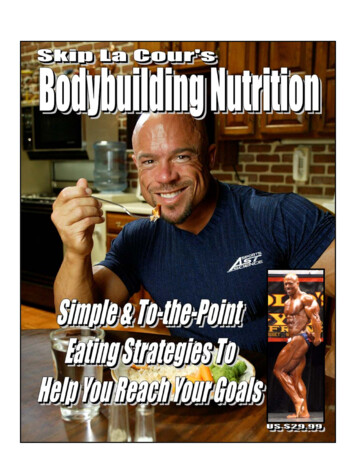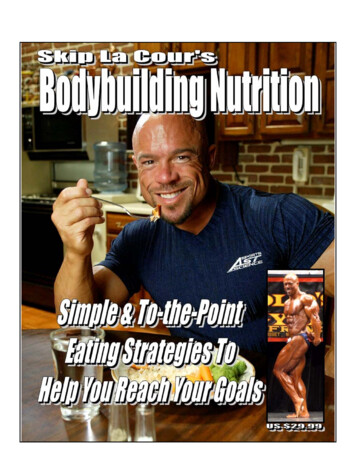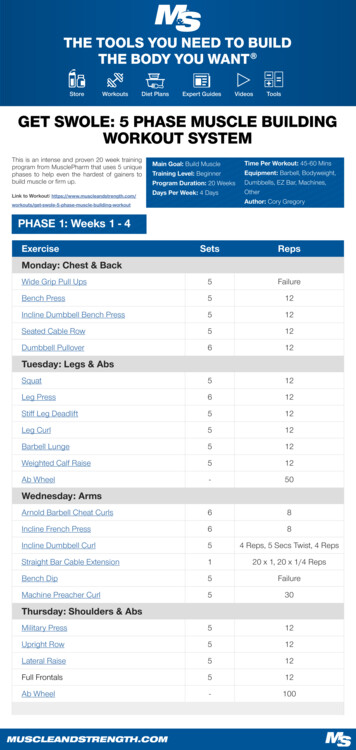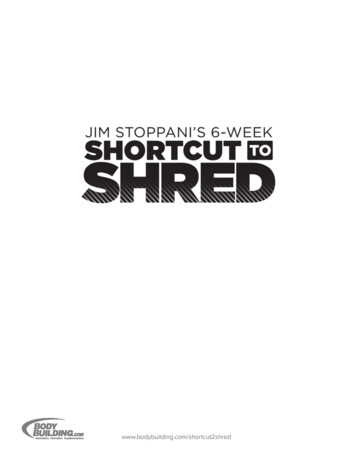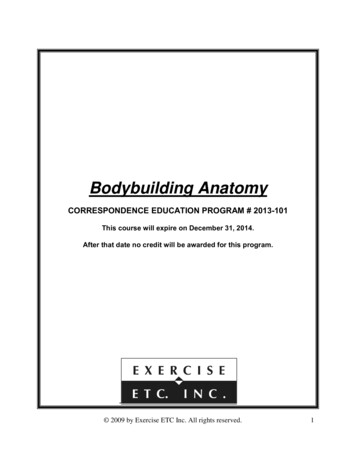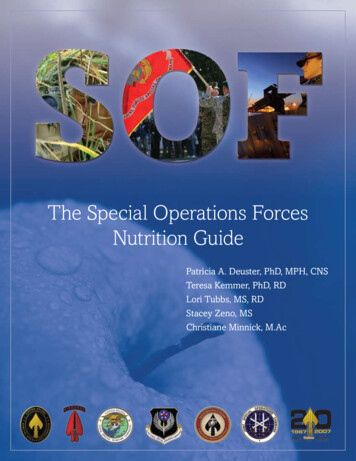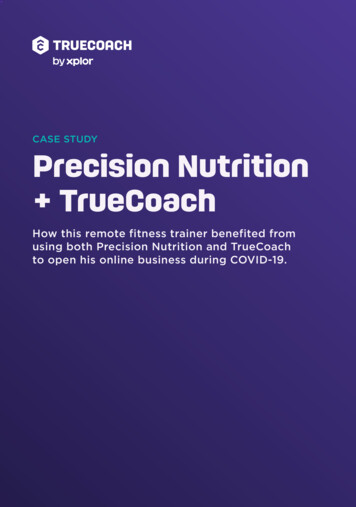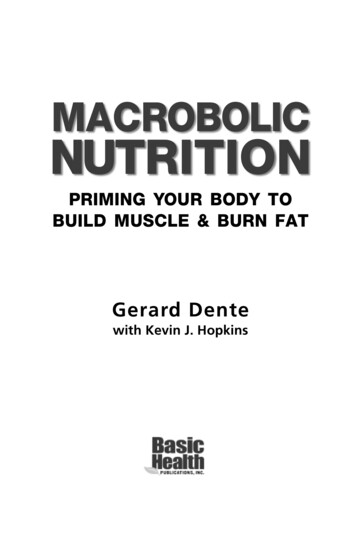
Transcription
MACROBOLICNUTRITIONPRIMING YOUR BODY TOBUILD MUSCLE & BURN FATGerard Dentewith Kevin J. Hopkins
The information contained in this book is based upon the research and personal and professional experiences of the authors. It is not intended as a substitute for consulting withyour physician or other healthcare provider. Any attempt to diagnose and treat an illnessshould be done under the direction of a healthcare professional.The publisher does not advocate the use of any particular healthcare protocol but believesthe information in this book should be available to the public.The publisher and authorsare not responsible for any adverse effects or consequences resulting from the use of thesuggestions, preparations, or procedures discussed in this book. Should the reader have anyquestions concerning the appropriateness of any procedures or preparation mentioned, theauthors and the publisher strongly suggest consulting a professional healthcare advisor.The author(s) of this book have a financial interest in some of the products recommendedherein.This does not constitute an endorsement by Basic Health Publications, Inc.Basic Health Publications, Inc.8200 Boulevard East North Bergen, NJ 07047 1-201-868-8336Library of Congress Cataloging-in-Publication DataDente, Gerard, 1967–Macrobolic nutrition : priming your body to build muscle and burn bodyfat / Gerard Dente with Kevin J. Hopkins.p. cm.Includes bibliographical references and index.ISBN 1-59120-131-41. Bodybuilders—Nutrition. 2. Macrobiotic diet. I. Hopkins, Kevin J.,1972– 4003217Copyright 2004 by Gerard DenteAll rights reserved. No part of this publication may be reproduced, stored in a retrievalsystem, or transmitted, in any form or by any means, electronic, mechanical, photocopying, recording, or otherwise, without the prior written consent of the copyright owner.Editor: Carol RosenbergTypesetter/Book design: Gary A. RosenbergCover photo: Per BernalKurt Angle photo on page 143 owned by World Wrestling Entertainment, Inc.and is reproduced with permission.Printed in the United States of America10987654321
Acknowledgments, vPreface, viiIntroduction You’re a Bodybuilder, So Eat Like One!, 11. Understanding Macrobolic Nutrition, 32. Carbohydrates—Don’t Count Them Out, 123. Protein—Choosing the Right Building Blocks, 284. Fat—It Is Essential!, 615. Water—The Nutritional Paradox, 686. Macrobolic Meals to Muscle Mass, 717. Guide to Estimating Caloric Requirements, 838. The Important Role of Micronutrients, 929. Enhancing the Macrobolic Nutrition Effect, 11910. Macrobolic Meals, 150Conclusion Progress Is the Great Motivator, 175Appendix A Macrobolic Caloric Requirements Tables, 176Appendix B Macrobolic Food Guide Pyramids, 189Appendix C Macrobolic Exchange Lists, 191References, 195Index, 207About the Authors, 214
Photo by Irvin J. Gelb.
THERE ARE MANY PEOPLE I WOULD LIKE TO THANK for their help, support,and friendship, but to name them all would take pages. I have been extremelyfortunate to have so many special people in my life.I want to give a special thanks to my mom, dad, sisters, brother, and mywife, Linda, for all of their continued support and for always allowing me topursue my ambitions and dreams.I want to thank all of the athletes I work with, particularly those mentioned in this book.Working with and knowing each of you is an honor anda pleasure. Each one of you is a champion. I especially want to thank DaveHawk for our friendship and Kurt Angle, a great athlete and role model, andan even greater human being.I am fortunate to be able to work in an industry I truly love. So, along withthe people I just mentioned, I want to thank all the people I work with atMHP and all those I work with on a regular basis in the nutrition industrywho have given me so much support and so many opportunities.You knowwho you are and I want to say . . .Thank you! Without your support, I wouldnot be able to continually pursue my passion to research and develop newproducts and educate myself and others on better ways to improve health andperformance.—Gerard Dentev
Photo by Irvin J. Gelb.
to finding ways to increase muscle massand improve physical performance. It started with my own personal quest toexcel in high school football and then as a national-level competitive bodybuilder. I was fortunate enough to have fairly good genetics for building muscle. However, I knew that in order to compete at the top-level ranks againstpeople with equal or better genetics, I had to compensate through a superiortraining and nutrition program. I know the extra knowledge of nutrition Igathered and applied toward my program helped me excel further than eitherI or anyone else had expected. During the time I was competing, I was able tomaintain an off-season body weight of 285 to 295 pounds at only 10 percentbody fat and a competition weight of 250 pounds at 4 to 5 percent body fat.This was back in 1995, an era when competing at 250 pounds was way abovethe norm.For most bodybuilders, the goal is usually to win in competition, but thereal motivation is to achieve the kind of personal progress that involves continually taking your body to the next level. That is what is so great aboutweightlifting and bodybuilding. If your focus is on your body and your external goals—the complete concept of what you want to achieve—bodybuildingcan be very fulfilling and rewarding.My personal quest to build my physique to its maximum potential throughproper training and nutrition led me to an exploration of the research anddevelopment of sports-enhancing supplementation. Because I relied on nutrition to gain a competitive advantage over my competition and to help mereach my full genetic potential, I dedicated a lot of time to researching nutrition and supplementation and their effects on muscle building and performance. As I learned more, I realized that there was a lot of room for improvementand advancement in the sports supplements being offered to athletes, and thisI HAVE DEDICATED MOST OF MY LIFEvii
viiiMacrobolic Nutritionultimately led to the creation of Maximum Human Performance, Inc., in 1997.MHP’s company mission is to provide athletes with the latest advancements insports supplementation.In addition to deriving inspiration from making progress and improvements in my own physique, I am inspired by public speaking and by helpingothers to achieve their fitness goals. I have given many lectures and seminars ontraining and nutrition over the years. Also, when you are a bodybuilder, yourbody serves as your uniform and it’s obvious that you work out. You becomea target for questions; so, no matter where you are, someone is almost sure toask you a question about training, diet, or supplementation. I must have fielded tens of thousands of questions over the years.It became obvious to me, by the number and kinds of questions that mostpeople ask, that they are completely uninformed about nutrition, and it isdisheartening to see how frustrated, confused, and misled they consequentlybecome. I’ve seen too many people working hard at the gym and not gettingresults. I’ve answered questions like “How do I get big?” “What should I eat?”and “What supplements should I take?” too many times. It is for this reason thatI felt compelled to write Macrobolic Nutrition.If you’ve ever asked or wondered about any of these questions . . . if youtrain hard and are unhappy with the results you’ve gotten, this book is for you!The answers and results lie within Macrobolic Nutrition’s 45/35/20 lean-massequation.I don’t proclaim to be a “diet guru,” nor am I going to try to take creditfor any great diet revolution. In Macrobolic Nutrition, I present scientific truthsabout nutrition in a simple, logical fashion. This book will help you understandthe enormous impact food has on your body. Macrobolic Nutrition can beapplied to anyone who is working out and who wants to build muscle andburn body fat.Those of you who are hardcore will see that Macrobolic Nutrition is the only way to make serious gains in “lean mass” and reach your fullgenetic potential. Macrobolic Nutrition is not a quick fix: it is a long-term permanent solution! There are other diets and nutrition programs that may helpyou lose body fat, but these diets typically compromise your ability to pack onmuscle. Macrobolic Nutrition will turn your body into an efficient musclebuilding, fat-burning machine! I am confident that Macrobolic Nutrition willwork for you as it has for me and for many others.—Gerard Dente
Preface ixto help write this book, I was skeptical. I understood that there was something missing within this industry, andbasic nutrition was it. Gerard and I are on the same page when talking nutrition, but I was just a little concerned that we would be trying to appeal to themasses and not deliver the facts we know actually work. I soon found out thatGerard had in mind exactly what I felt was needed to guarantee bodybuildingsuccess.My background is in pharmacy and biochemistry, so naturally, the hormonal environment created in the body by foods and supplements was a vitalinterest of mine. For a few years, I worked with one of the largest compounding pharmacies in the country. I was exposed to hormonal replacement therapy practiced by some of the top physicians in the world during that time.Themissing link for most patients was addressing their nutritional protocol. Thisslight oversight actually decreased the effectiveness of their therapy. As timewent on, my love for bodybuilding and interest in nutrition drove me to opena health food store in 1995.The business grew and satisfied my desire to helpeducate people on the correct usage of vitamins, sports supplements, and herbs.Finally, I became a partner in a large fitness center and moved the entire healthfood store into the facility in 2003. I now had the ultimate approach for serving the bodybuilding community: a large state-of-the-art fitness center complete with all the cutting-edge supplements to enhance performance. I alsobegan competing on the state level in the NPC as an open middleweight-classbodybuilder. My conditioning at contest time and my ability to stay rippedyear-round drew a lot of attention from fellow competitors and patrons of ourgym. Constantly barraged with questions, I felt it necessary to put it all in writing so the explanation would be easily followed.I met Gerard quite some time ago, through my work with different physicians. One of his close friends was a client of the pharmacy where I worked,and I was very familiar with Gerard’s lengthy list of bodybuilding accomplishments. Aware of each other, we finally met by chance at a New Jersey NPCbodybuilding competition. Gerard was there to launch a new supplement. Weimmediately struck up a conversation, and much to my surprise, he was veryknowledgeable. My background in pharmacy and biochemistry intrigued him,and a friendship was formed instantly. I was very impressed with the fact thatGerard had a level of nutritional knowledge few bodybuilders could hope topossess. Coupled with his freaky genetics and 250-pound competition weight,this insightful look into nutrition turned him into an all-out superfreak!WHEN GERARD DENTE APPROACHED ME
xMacrobolic NutritionNot long after our chance meeting, Gerard asked me to assist with theproduction of some new supplements to propel his company to the top of theindustry. I agreed, and over the next few years TRAC, T-BOMB, TakeOFF,and their latest creation “The Up Your MASS” line were born. My background in pharmacy and drug-delivery systems proved to be invaluable for theinvention of the enteric-coated delivery system of T-BOMB, which quicklybecame the number-one-selling prohormone in the country.Now our chance meeting has evolved into my coauthoring MacrobolicNutrition. I strongly encourage any and all athletes who are serious about leanmuscle growth to try the Macrobolic Nutrition food plan.We address everything from protein, carbohydrates, and fats to the effects these macronutrientshave on the hormones in the body. This book will be the most valuable toolin your muscle-building arsenal—just as important as the weights you lift andthe recovery time you require. Macrobolic Nutrition will put you at the top ofthe food chain for the maximal results from your training efforts.—Kevin J. Hopkins
INTRODUCTIONYOU’RE DEDICATED AND COMMITTEDto building an impressive, sculptured,muscular physique.You train four, five, or maybe even six times per week andstick to a strict diet to achieve the same look as those impressive professionalbodybuilders you see in the magazines. Some of you may have been workinghard at it for years, while some of you may be just getting started. For those ofyou who have been working at it for years, I say,“I’m sorry that you have beenso dedicated and worked so hard, and still haven’t figured out why you’re notmaking serious gains and continual progress.” For those of you just starting out,I say, “Congratulations—you are about to save yourself from years of hardwork, trial and error, and frustration and misery.” So, what is the secret of topbodybuilders? What do they know that you don’t know? Why does the modernday bodybuilder keep getting bigger and bigger and freaky ripped?Come on; take a guess. I’ll give you some clues. It’s not their training, andit’s something you consume every day. If you didn’t figure it out, I’m going totell you: FOOD! Yes, something as simple as food makes the whole difference.The foods you eat can have a tremendous impact on building a lean, muscularphysique—even greater than your training. We all train hard yet we all can’tachieve the degree of hard muscularity we desire.And don’t blame your genetics, because unless you fuel your body with the proper nutrition, you will neverreach your full genetic potential. Granted, we can’t all be Mr. Olympia, but wecan certainly improve our physiques. I’m not talking about little changes. I’mtalking about changing your biochemistry and priming your body to becomea muscle-building/fat-burning machine.Your body will efficiently build muscle and burn off body fat twenty-four hours a day, seven days a week, and 365days a year.Your muscle mass will continue to increase, your body fat will godown to your desired level, and your strength and energy will go through theroof.All of these changes will occur simply by changing the way you eat. Oh,1
2Macrobolic NutritionI almost forgot to mention, you won’t be doing cardio anymore! (You’ll haveto keep reading to find out how to get ripped without cardio.)No doubt you’ve tried all kinds of diets and none of them worked—that’smy point! Macrobolic Nutrition isn’t like any other diet. Macrobolic Nutritionwas designed for the hardcore, serious bodybuilder/athlete aiming to pack onlean muscle mass, increase strength, and improve performance.The nutritionalrequirements of bodybuilders and athletes far exceed those of the average person, because the physical demands a bodybuilder places on his or her bodygreatly increase the need for nutrition to help the body build and repair itself.When you add the goal of building huge amounts of muscle while decreasingbody fat into the mix, it’s easy to see why most people never reach their fullgrowth potential.The purpose of this book is to give you an understanding of food’s impacton the many biochemical processes in the body that influence muscle growthand fat burning.The science behind Macrobolic Nutrition is very advanced,but I have simplified it to make it easier to understand, and most important,so that you can apply it to achieving your goal to pack on lean mass. You mayfeel the information is too detailed or scientific at times, but keep reading andit will all come together. Up until now, how to get big and “shredded” hasremained a mystery to you. Macrobolic Nutrition is like a good mystery novel.You will pick up key pieces of information, “clues,” throughout the book onhow to get massive and ripped, and by its conclusion, you will have finally figured out the mystery of how to pack on lean mass!Here are some highlights of what you are about to learn: First and foremost, not all calories are created equal. Macrobolic Nutrition teaches you how tochoose the right sources of carbohydrates, proteins, and fats. Macrobolic Nutrition’s 45/35/20 lean-mass equation shows you how to eat these sources in theproper ratio of macronutrients so they are optimized for your ability to buildmuscle, burn fat, and increase performance. You’ll also learn about the importance of water, vitamins, and minerals.Macrobolic Nutrition’s “Guide to Estimating Calories” will help you calculate the exact amount of carbohydrates, proteins, and fats that you needto achieve your goals. This book even provides a Macrobolic meal menu, soyou can eat a variety of delicious foods and make Macrobolic Nutrition anenjoyable and easy-to-follow program. If you want to be at your best andmake continual gains in your bodybuilding efforts, Macrobolic Nutrition willget you there.
CHAPTER 1EVER WONDER WHY ALL OF THE BIGGEST and most ripped guys in the gymare on the weight room floor moving heavy steel, while all of the overweightor skinny guys are on the cardio machines?How would you like to be able to pack on muscle and lose body fat without ever having to do cardio again? Yes, you read it right. Pack on muscle andlose body fat without ever doing cardio! You are about to learn how the topbodybuilders in the world pack on muscle and stay hard year-round, withoutcardio and without starving themselves. It all comes down to food, and whatprofessional bodybuilders call Macrobolic Nutrition’s lean-mass equation.Macrobolic Nutrition heralds a new era in bodybuilding and performanceenhancement.This nutrition program is designed to create the ideal metabolic and hormonal environment for incredible gains in muscle size, strength, andendurance, while burning fat quickly and efficiently. In fact, your body willbecome so metabolically efficient, you won’t have to do cardio to burn bodyfat.You won’t have to starve yourself either.You’ll be eating more food thanyou could imagine every two and a half to three hours. But before I get intothe specifics and science of Macrobolic Nutrition’s lean-mass equation, let’sclear the air right now about the biggest mistake amateur bodybuilders makein their quest for rock-hard mass—low-carb diets.The huge amount of mediaattention on low-carb diets may have led you to believe that was how to get alean, muscular physique. Unfortunately, you probably found out the hard waythat a low-carb diet isn’t giving you the results you want. Rather than becoming big and hard with dense, full muscles, you feel small, flat, and weak! If youdon’t believe me, keep reading, because science doesn’t lie. Not only doesscience prove it, the impressive mass achieved by the world’s top bodybuildersproves it as well.3
4Macrobolic NutritionTestimonialPhoto by Reg Bradford.“Early in my bodybuilding career, I madethe mistake of going on a low-carb diet thelast twelve weeks before a show. I alwaysended up losing a ton of muscle mass andalways showed up looking flat, small, andsmooth. Macrobolic Nutrition has made allthe difference in the world. Now, insteadof losing mass pre-contest, I actually growright into the show. This allows me to hitthe stage looking hard, dense, and full.”—Chris “Big Guns” Bennett,NPC Top National BodybuilderMACROBOLIC NUTRITION’S 45/35/20LEAN-MASS EQUATIONThe 45/35/20 lean-mass equation is the foundation of Macrobolic Nutrition.This will be the equation for your success in achieving your muscle-buildingand performance goals. 45/35/20 represents the ratio of carbohydrates, proteins, and fats you need to consume in your diet. I didn’t pick these numbersrandomly. They are based on proven science and my own personal experienceof what your body needs to stimulate muscle growth, burn fat, and supportrecovery. If you are putting your body through rigorous workouts to buildmuscle and burn body fat, you better be taking in the proper nutrition. Otherwise, all your training efforts are going to be for naught, and you’ll nevermake the gains you’re looking for. The reason why most people never reachtheir full growth potential is not because of their lack of training, but becauseof their lack of nutrition.Macrobolic Nutrition heralds a new era in performance enhancementwith its design to create the ideal metabolic and hormonal environment for increased muscle size, strength, and endurance, while reducing body fat. Macrobolic’s fundamental principle that “all calories are not created equal” is sure toraise controversy. Many other diets are based on the simple premise that caloricintake minus caloric expenditure determines weight gain or weight loss.Thisis true to an extent, but it is oversimplified when your goal is to improve bodycomposition by adding lean mass and decreasing body fat. I am not disputingthat every gram of protein yields four calories, every gram of carbohydrate
Understanding Macrobolic Nutrition5TestimonialPhoto by Garry Bartlett.“When I turned pro in 1997, I competed at a bodyweight of only 211 pounds. I knew that in orderto compete as a pro, I needed to be much bigger.I went to Venice, California, to find out whatthe secret was on how these guys were gettingso huge. Believe it or not, I found out all the toppros were following the same basic principlesof Macrobolic Nutrition. Making these simplechanges is all it took and now I compete at over230 pounds. And the only thing I changed wasmy diet.”—Mike Morris, IFBB Professional Bodybuilderyields four calories, and every gram of fat yields nine calories. However, theseoversimplified diet programs, written by so-called “diet experts,” recommendthat you consume less food (calories) than you burn (expend) if you want tolose weight, and more calories than you expend if you want to gain weight.Wow—isn’t that brilliant?! How many years of school did they have to gothrough to come up with such an earth-shattering revelation?Well, it’s not that simple. Whether you are trying to gain weight or loseweight, these primitive diet plans will lead anyone to fail in obtaining his or hergoals, especially bodybuilders and athletes. If your goal is to gain weight, you’llgain weight all right, but it will be all fat! I know you’re not busting your assin the gym lifting the heavy iron to put on fat. When a bodybuilder says hewants to get big, he’s talking about packing on rock-hard slabs of muscle, notabout becoming a “big fatty.” Conversely, if you follow this kind of diet plan forweight loss, half of the weight you lose in the first month will be fat, but theother half will be hard-earned lean muscle. After the first month or so, yourmetabolism will slow down so much and you’ll be eating so little that mostadditional weight loss will be muscle.All that hard work you put in at the gymtrying to build muscle will be wasted. Eventually, you’ll be left with a thin, soft,mushy body—what I call a “thin fat” body. Worse yet, you’ll get so disgustedwith these diminished results that you’ll start eating poorly again out of frustration, and will blow up into a “big fatty.”I’m not trying to sound obnoxious, but these diets, which so many people
6Macrobolic Nutritionfollow, set them up for failure. And it annoys me to see people bust their assesin the gym, while they follow these diets, only to be disappointed.I can’t take full credit for many of the key scientific approaches used todevelop Macrobolic Nutrition. I must commend both Dr. Robert Atkins andDr. Barry Sears for paving the way and opening the eyes of the medical community and dieticians, who are often blind to new science. I’m sure most ofyou are familiar with Dr.Atkins’s high-protein/very low-carb “Atkins diet” andBarry Sears’s “Zone diet.” Both of these diets have considerable scientific meritand have been effectively used for weight reduction by millions of people. Butwhat effect do they have on muscle mass and performance?The fundamental theory behind the Atkins diet involves ingesting caloriesprimarily from fat and protein.Your body resorts to using stored body fat as anenergy source when carbohydrates are restricted from the diet. This process isknown as ketosis. However, your body may switch to protein as another sourceof energy, instead of entering ketosis.When this happens, the liver converts protein into blood sugar via a process called gluconeogenesis.This is where the controversy for athletes begins to arise. How will your body discriminate betweenthe protein in muscle or the body fat stored around it? While there is no doubtthat the Atkins diet leads to weight loss in inactive people, it can lead to disasterfor bodybuilders and athletes. A no-carbohydrate diet such as the Atkins dietleads to low energy levels and hinders performance. It also will lead to loss ofmuscle and ineffective recovery from exercise. Studies performed by the U.S.Olympic Committee have shown that an intake of anything less than 42 percentcarbohydrates will hinder performance and energy. Carbohydrates are stored inthe muscle as glycogen. Glycogen is what muscle uses for energy. In the absenceof carbohydrates, precious protein is converted to glycogen instead of being utilized as a building block for muscle growth.This is the last thing a bodybuilderwants to have happen.To make matters even worse, gluconeogenesis, the processfor converting protein to glycogen, is not nearly as efficient as the process of converting carbohydrates to glycogen, so less glycogen will be present in the muscle if carbohydrates are not available. Plus, glycogen makes muscles look full andhard, so a low carbohydrate intake is going to result in flat, soft-looking muscles.The bottom line is that your nutritional requirements are different fromyour mom’s, so get off her diet.A no-carb diet will hinder your ability to packon muscle, and will leave you feeling weak and looking flat and small. You bustyour ass in the gym to look good, so why waste your efforts by eating thewrong foods? Your body needs the right nutrition to get big and ripped!Barry Sears’s Zone diet is a little closer to the mark. Sears’s approach closely examines blood sugar stabilization and insulin levels, much the way thatMacrobolic Nutrition does. In the Zone diet, 40 percent of your calories come
Understanding Macrobolic Nutrition7About GlycogenGlycogen is a long chain, or polymer, of glucose molecules that isstored in the brain and liver, but mostly in muscle. Our bodies store carbohydrates as glycogen to be used for energy and to stabilize bloodsugar during activity. As a rule of thumb, our bodies will store about60 grams of carbohydrates in the liver and about 300 grams in the muscle, all of this as glycogen. Of course, the bigger you are and the moremuscle you have, the more glycogen you can store. This is anotherbenefit of having more muscle tissue than body fat. This is one ofthe reasons why a 250-pound athlete requires more carbohydratesand calories than a 160-pound athlete. Muscle glycogen is importantto support your energy demands during workouts and to prevent thecatabolic process gluconeogenesis.from carbohydrates, 30 percent from fat, and 30 percent from protein. Sears’sratios are fine for a nonathlete and close to ideal for a regular athlete, but the30 percent fat proportion tends to compromise the quality of the calories consumed. In order to eat that amount of fat, I feel you will inevitably raise yourintake of saturated fat. Macrobolic Nutrition puts more emphasis on the quality of the calories you eat. When it comes to outrageous muscle growth, theZone just does not pack the punch you need to pack on the mass. It proveseffective for endurance athletes, but falls short in protein demands for bodybuilders and strength athletes—for them, too little protein will hinder performance, recovery, and muscle growth. Macrobolic’s shift in caloric ratios isjust what your body needs to keep it in an anabolic state, the state in whichnew muscle is built.Success with Macrobolic Nutrition relies not only on using the 45/35/20lean-mass equation for your diet, but also in selecting the right sources andcombinations of macronutrients (carbohydrates, protein, and fats) to maximizelean mass, strength, and overall performance. Macrobolic Nutrition’s key pointsinclude optimizing and regulating hormones, meal frequency, the thermogeniceffect of food, and its net effect on metabolic efficiency. These scientificallyadvanced concepts will be discussed in easy-to-understand detail so you canapply them to your training program.Because every athlete is at a different level of conditioning, MacrobolicNutrition outlines three different formulas for calculating your total Macrobolic caloric needs. (See Chapter 7.) Use these formulas to calculate your own
8Macrobolic Nutritioncalorie requirements based on your current condition and goal.A Macroboliccaloric requirements table for each goal is included in Appendix A to make following the program even easier.These tables give the amount of carbohydrates,proteins, fats, and total calories athletes should consume depending on theirlevel of conditioning. You will be able to customize a Macrobolic Nutritiondiet specifically for you, taking into account your current body weight andbody composition, occupation, lifestyle, workout regimen, and most important, your goal!GOALS Gain Lean Muscle/Lose Body FatGain Lean Muscle/Maintain Current Body FatGain Lean Muscle/Gain Body FatThe key to any long-term nutrition program is consistency, but don’t worryabout this being a boring diet. Chapter 10 presents some really tasty Macrobolicmeals for you. From quick meals to exotic specialty meals, they are all deliciousand they are all Macrobolic! The longer you follow Macrobolic Nutrition, thebigger, leaner, stronger, and healthier you will become.You
genetic potential.Macrobolic Nutrition is not a quick fix:it is a long-term per-manent solution! There are other diets and nutrition programs that may help you lose body fat,but these diets typically compromise your ability to pack on muscle. Macrobolic Nutrition will turn your bo
